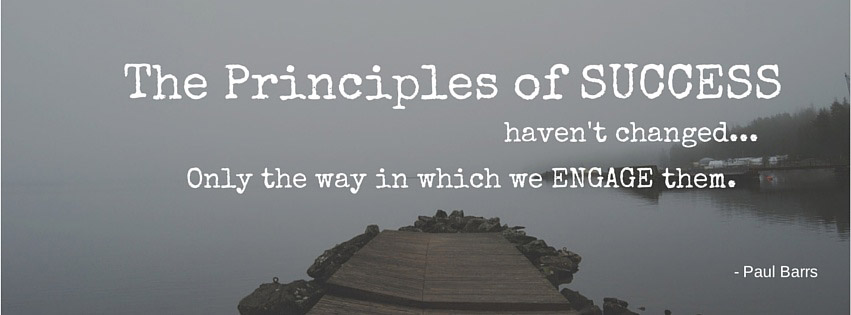
24 Oct The Foundation Principles For Online Business
By Paul Barrs.
Imagine for a moment that you go to sleep tonight, dream for what seems live forever and when you wake, it is a whole year later. Or that for whatever reason you decided to turn of your computer and throw it out the window… waiting a full year before you bought another one.
What would the internet and web business world be like, how would it have changed? Would some things have also remained the same? Have the foundation principles moved with the times also?
Recently I had the opportunity to do just that (well, figuratively speaking anyway). I came across an old backup drive with a whole bunch of training material from not one year ago, but four years ago!
What an adventure, an eye opener and a revelation of knowledge.
Want to know what I found? Simply this, that there are certain foundation principles for your web business that have not changed – even in all that time. Sure there are certain things that have changed in the “way” that we DO business, but not in the WHY.
These days it has become obsessively prevalent that we purchase the ‘latest gadget’ or participate in the ‘present scheme’ or whatever – and keeping in mind that while many of these things do work and get results – they provide results ONLY until their saturation point arrives and the customer turns away from them.
Remember: The Foundation Principles Never Change!
I don’t know about you, but I’m sick of it. I mean, do we really have to completely re-train, relearn and re-model our websites every six months just to make money from them? No. Following are my personal foundation principles for your web business; these are the absolute minimum strategies that must be built into every website that you build. No exception, no ifs or buts.
These foundation principles have and will continue to outlast every new and up-and-coming ‘guru technique’ ever devised. Learn those techniques, sure, but be sure to place them on top of the foundation, because if you “build on the sand…” well, you know the story.

1. Ease of Use Design and Structure
This goes without saying, and unfortunately it often *does* go without saying. Have you noticed how often that when you go to do a search these days all you end up getting is a whole bunch of junk results with completely user non-friendly sites? It’s vitally important that we consciously decide to design and create our websites for the customer, not the business. They must be easy to use, easy to navigate and pleasant on the eye. Forget about what’s easy for you to build, ask instead what’s easy to use.
2. Call to Action Copy
My personal favourite. Yes, the site must be easy to navigate and use, but it must also be easy to READ. This is where your sales copy comes in. Sometimes (most often in fact) your customers will come by your site just ‘looking around’ (that’s why web browsers and called web *browsers*). Often, they don’t even know what even they really want – and that’s where you ‘call to action’ copy comes in. Use it, not to flog some product, but to help guide and direct your customer through your site. A successful website isn’t just one that is easy to use; it’s also easy to walk through.
3. Automated Follow-up
Are you awake 24 / 7 and able to take eMail inquires? Probably not. And while, yes, you can employ people on the other side of the planet to take your online help registrations, you probably don’t have too when most people ask the same darn questions over and over again.
How about your sales team, do they work 24 hours a day? Not likely. But your website will, and does. This why it’s vital that you employ some kind of automated follow-up strategy. Most commonly this is done through an eMail autoresponder, though not always. You can also build follow-up into a membership site, a customer registration site, a whatever – it doesn’t matter HOW, it just matter WHEN. So when you should do it if you haven’t done it yet? Now is the best answer. So just as your site becomes easy to navigate, your call to action copy can help direct your customer to your automated follow-up system. That way you can keep in touch with ‘prospects’ that you would have otherwise lost and missed out on.
4. Socially Networked
OK, this is the one item on the list that has changed over recent years – but only in technique, not principle. The thing is, not everyone wants to give you their name eMail address through some subscription form, but they are still ‘curious’ enough to want to see what you’re doing, what your saying and often waiting to see if you build confidence with them – that’s where social networking comes in.
Ten years ago we asked people to ‘bookmark’ out websites; these were the foundation principles. But now we ask them to ‘friend us on FaceBook’ or ‘follow us on Twitter’. Doesn’t matter what it’s called, it’s all the same thing, just different medium. There’s LinkedIn, Digg, Stumble… the list is endless. The point here is that if your (potential) customer isn’t going to contact you directly, buy from you and subscribe to your list, you can at least keep them in touch through your social media updates. It’s also a great opportunity to begin building a ‘relationship’ with them – and while such relationship will never be better than or replace a face to face or phone to phone relationship – it is a start nonetheless.
5. Sales Orientated
Now we’re getting to the meat, and this is a vital KEY…. No matter what your focus, what your product, or what your service; every single thing that you do must be done with a ‘sales focus’ in mind. That’s the whole point isn’t it, to generate sales, build your business and create income? Of course. Therefore, keep in mind that whatever you do, whether it be through FaceBook or through your autoresponder, you must build confidence in with your customer and ask them to ‘buy’ from you. It doesn’t always have to be a cash purchase though – it could be a digital download, a free give-a-way, an eBook, an audio eCourse – a whatever. These smaller ‘purchases’ help the customer build trust, moving them ever closer to the final goal of all customer / business relationships, cash purchases.
Everything you do must have that ultimate goal in mind. Just remember that some people (most people) need to jump though a few hoops to get there first.
6. Forever Fresh
Finally, it should go without saying, but it has to BE said – is that you must keep your website FRESH and UPDATED! People don’t want to read stale old information from five years ago, they want to know that you care about them (and yourself) enough to have updated the content on your website.
Does that mean that you need to change up and completely redo everything each year? No. Especially if something you’ve got there is working – of course you wouldn’t change it. But you can continue to update and keep things fresh in many different areas. The key: foundation principles DON’T change…. only technology does.
What am I doing right now? I’m writing an article that I’ll post to my Blog. Could you do the same? How about in audio? How hard would it be to begin a weekly Podcast? What about video? Could you start your own YouTube Channel? Of course you could. In fact I suggest you do – because once the foundations of your web business are in place (all of the above points), you won’t need to do anything else except promote your website through articles, links, joint ventures, posts, pods and so on.
And that’s the beautiful part of it. These principles never change. Set your foundation firm in the first place and you’ll then find that you can weather any storm that time brings to you. It will no matter what ‘the other guy’ is doing, your customers will love you for who YOU are, and what you do for THEM.
This is one of the most important foundation principles ever!



